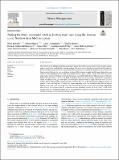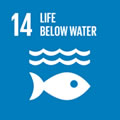Por favor, use este identificador para citar o enlazar a este item:
http://hdl.handle.net/10261/331243COMPARTIR / EXPORTAR:
 SHARE SHARE
 CORE
BASE CORE
BASE
|
|
| Visualizar otros formatos: MARC | Dublin Core | RDF | ORE | MODS | METS | DIDL | DATACITE | |

| Título: | Fishing for litter, accidental catch in bottom trawl nets along the Catalan coast, Northwestern Mediterranean |
Autor: | Balcells-Surroca, Marc CSIC ORCID; Blanco, Marta; Colmenero, Ana I. CSIC ORCID ; Barría, Claudio CSIC ORCID; Santos-Bethencourt, Ricardo CSIC ORCID ; Nos, David CSIC ORCID ; López-Pérez, C. CSIC ORCID; Ribera Altimir, Jordi CSIC ORCID; Sala Coromina, Joan CSIC ORCID ; Garriga-Panisello, Mariona CSIC ORCID; Rojas García, Alba; Galimany, Eve CSIC ORCID | Palabras clave: | Marine litter Plastic Trawling Depth Wet wipes Fisheries |
Fecha de publicación: | jul-2023 | Editor: | Elsevier | Citación: | Waste Management 166: 360-367 (2023) | Resumen: | The seafloor of the Mediterranean Sea accumulates marine litter (ML), an area where bottom trawlers operate and can accidentally catch the litter from the seafloor. This study aims to describe and quantify the ML caught by bottom trawlers along the Catalan coast (NW Mediterranean Sea) and estimate the potential of the bottom trawl fleet to extract ML from the area as a Fishing for Litter (FFL) initiative to tackle the ML issue. Marine litter was collected from commercial trawlers and was classified as metal, plastic, rubber, textile, wood, and other waste and weighed (kg) from 305 hauls performed during three years (2019–2021) from 9 different ports at 3 different depths. ML was present in 97 % of the hauls, with plastic being the most abundant material. The composition varied according to zone, port and depth, with the highest densities found in highly urbanized areas (13.75 ± 3.25 kg km−2), which mainly contained plastics (74.3 %). The port of Barcelona had the highest presence of plastics (23.62 ± 6.49 kg km−2), mainly wet wipes. Regarding depth, the continental shelf had the highest density of ML, with 12.24 ± 2.40 kg km−2. The potential ML removal (t year−1) was calculated using fishing effort (hours). It is estimated that the bottom trawlers may potentially remove 237 ± 36 t year−1 of ML in the Catalan coast. FFL initiatives should be part of a multidisciplinary approach to tackle marine litter, which must include prevention, monitoring, and cleaning actions | Descripción: | 8 pages, 6 figures, 1 table, supplementary material https://doi.org/10.1016/j.wasman.2023.05.021.-- Data availability: Data will be made available on request | Versión del editor: | https://doi.org/10.1016/j.wasman.2023.05.021 | URI: | http://hdl.handle.net/10261/331243 | DOI: | 10.1016/j.wasman.2023.05.021 | ISSN: | 0956-053X |
| Aparece en las colecciones: | (ICM) Artículos |
Ficheros en este ítem:
| Fichero | Descripción | Tamaño | Formato | |
|---|---|---|---|---|
| Balcells_et_al_2023.pdf | 1,96 MB | Adobe PDF |  Visualizar/Abrir | |
| Balcells_et_al_2023_suppl.odt | 24,48 kB | OpenDocument Text | Visualizar/Abrir |
CORE Recommender
SCOPUSTM
Citations
1
checked on 11-may-2024
WEB OF SCIENCETM
Citations
1
checked on 20-feb-2024
Page view(s)
65
checked on 15-may-2024
Download(s)
48
checked on 15-may-2024
Google ScholarTM
Check
Altmetric
Altmetric
Este item está licenciado bajo una Licencia Creative Commons



